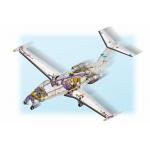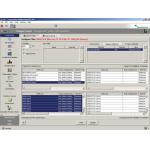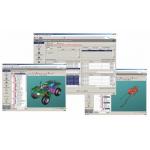Latest News
September 1, 2005
By Stu Johnson
The days of multiple physical prototypes are over. No company in today’s competitive global market needs to spend the time and money required to make and break them. At the same time, product quality is even more important to remaining competitive and the virtual prototypes that have largely replaced physical ones must work for product validation.
Because products are seldom designed as one-size-fits-all objects, digital prototypes must incorporate the multiple versions, options, or variances that characterize most complex products. This means that manufacturers need more than visualization and digital mockup capabilities from virtual prototype technology; yet these tools remain integral to the process of design validation.
Virtual prototype can be defined in a number of different ways, depending on who’s defining it. People working with MCAD, CAE, digital mockup, or a bill of materials all see it differently. In the widest sense, a virtual prototype starts with a digital product definition, created when a design project gets checked into a PDM (product data management) system under the product name. If it’s a product with multiple configurations, the variations need to be defined as well.
|
|
| Digital mockup of the Eclipse 500 showing electrical and fluid routing. |
Today’s user of virtual prototyping technology needs the digital prototype to handle many options over the whole product lifecycle, starting with concept, and going on to styling, product design, engineering, manufacturing, sales, maintenance, and retirement. No one software vendor has gotten all the way to that goal yet, but processes such as repeatable digital validation (RDV) have made important strides in that direction.
It doesn’t make sense today to speak about a single virtual prototype. Products being prototyped need to be broken down for different configurations and different assemblies within those different versions. The big picture requires being able to see today’s latest and greatest design iteration and then use it for configuration management and product validation on an ongoing basis.
Because no complex product design can be finished in a single session, or by a single person, and because the design keeps changing, the PDM system housing the digital prototype needs to handle multiple changes to multiple configurations every day. People viewing the digital prototype know that actions taken on one subassembly can affect others. If a design review done one day results in various action items, many subsystems will need to be examined the next day. The virtual prototype needs to be sufficiently dynamic to act as a real prototype, enabling identification of such issues as clash and interference, and reflecting the changes they cause.
Repeatable Digital Validation
The UGS RDV system for creating and managing such dynamic virtual prototypes is both a module and a process. An RDV module in Teamcenter makes it possible for engineers to automatically create JT files—neutral 3D format files for visualization, collaboration, and interoperability—of their designs, which are synchronously managed by the PDM system. Together with engineering product management and design context tools, RDV becomes a process for both scheduling and managing continuous digital validation, as it captures a design at every stage, and reuses the configuration through repeated updates.
The system is rules-based, and the engineers working on an assembly create the rules. For example, in the case of an automotive fuel system assembly, it’s important the fuel line is protected from other parts that might become hot. To accomplish this, the fuel system’s design team can insert a rule in the RDV system stipulating that the fuel line must be X distance from parts that generate Y operating temperature. That rule connects with a clearance database, and the system flags the pertinent engineers, listing all parts that break the heat-distance rule.
|
|
| By querying product structures for rules like spatial relationships, the subsystem models, here the fuel tank and components within 100mm of it, can be viewed along with all pertinent data. |
Validation rules will continue to operate for as long as needed. The system automatically checks whenever someone makes a design change and checks the model back into Teamcenter. In this way, potential problems can be detected and dealt with before the change reaches the revision stage.
Remember, though, there can be 100 engineers working on 100 different subsystems (possibly a conservative estimate) on any one design project. Each sets up his or her own set of rules because each engineer’s familiarity with a particular design or subsystem informs their understanding of what to worry about in a particular subassembly. When using a sophisticated RDV system, no one has to worry about what concerns the others because they use the same RDV system to catch rule conflicts. The RDV system determines “issues” or output from the database for further study to avoid errors. As work progresses, the RDV system runs in the background continuously.
Not only does RDV provide design context and visualizations to users who can use visualizations to answer questions about interferences, spatial relationships, and exact measurements, it also allows them to open an MCAD file to fix problems they’ve discovered. Repeatability is provided because the system automatically sweeps through all the changes made in a day and harvests them for review the next day when the saved queries can be reused on a new iteration.
Applying Repeatable Digital Validation
When Eclipse Aviation of Albuquerque, NM, developed a plan to create a six-person twin-turbofan jet aircraft costing less than popular turboprops, the company started by building a new factory and placing IT at the top of its priorities. A key part of Eclipse Aviation’s IT strategy consists of UGS Teamcenter PLM with RDV.
“We don’t have time to learn from prototypes,” says Oliver Masefield, senior vice president of engineering at Eclipse. “Our ability to meet our targets depends on digital mockup and validation. This allows us to achieve a degree of optimization that was previously only possible with hard prototypes. The ability to create digital mockups and validate them in software means that our prototypes are production representative aircraft.”
This capability made it possible for the company to work with the FAA using digital models of the Eclipse 500 instead of paper drawings. The agency usually requires the latter. In addition, because Eclipse proved that it can access product information quickly and accurately, the FAA conducts design reviews with Eclipse, using the company’s digital models. It also allows the company to maintain its own documentation, rather than requiring a complete set to reside with the agency.
|
|
| Complete product structures can be queried for rules such as spatial relationships to identify desired components quickly. Here the components within 100mm of the fuel tank are identified. |
Eclipse uses its RDV prototypes for design reviews held three times a week during the intensive design process. Everyone involved with a particular section of the aircraft, including suppliers, gets together to go over recent updates. The entire digital aircraft represents tens of thousands of parts; many part of sub-sections that are very large. RDV makes it possible to zero in on the segment of interest very quickly, in response to such search criteria as: Show me everything connected to the cooling system.
“RDV lets us navigate through the entire plane quickly,” says Masefield. “We can create the precise digital mockups we need at any given moment. This has transformed the design process by allowing our designers to conduct iterations to optimize the design and keep up-to-date with current product configurations. We use RDV company-wide to permit true concurrent engineering across all disciplines.” He adds that it has also helped engineers detect design errors early, especially cross-disciplinary errors that might not otherwise show up until a physical prototype is built.
Greater Capabilities Still to Come
Just as current users of RDV can open their MCAD files directly from the RDV digital prototype, others will soon be able to open CAE tools for further analysis. And as today’s users can perform clash and proximity studies, they will soon be able to use RDV for cost-weight analyses, to drill down into bills of materials, and to perform all of these tasks simultaneously.
In a normal digital environment, using only MCAD, engineers might be able to manage review and changes for five different variations on a product. With visualization, digital mockup, and configuration management, they might be able to manage between 10 and 15 variations. RDV helps companies manage hundreds or even thousands of variations. Modern car makers let buyers specify everything they want in their vehicles on line, so that the manufacturer virtually produces custom cars. The same is true for aircraft; no two are alike. RDV enables companies to deal with this level of complexity by making it easier to evaluate the impact of design decisions on each variation.
And RDV reduces cycle time. It used to take weeks to create a digital mockup of a complete, complex product such as the Eclipse 500 discussed above, meaning that people in a design review did not have access to the latest changes. Today, engineers can perform what-if iterations and find out the next day whether they work. Some companies, currently able to validate all options at the same time, have reduced design cycle times by 60 percent, and are aiming for 75 percent.
Stu Johnson is the product manager for the Teamcenter Visualization product line at UGS, where he has worked for two years. He has more than 15 years of experience in the CAD/CAM/PLM industry in sales, management, and marketing. Johnson earned his M.E. degree from Cal Poly University. You can send comments about this article through e-mail by clicking here.
Product Information
Eclipse Aviation
Albuquerque,NM
Teamcenter
UGS Corp.
Plano,TX
Subscribe to our FREE magazine, FREE email newsletters or both!
Latest News
About the Author
DE’s editors contribute news and new product announcements to Digital Engineering.
Press releases may be sent to them via [email protected].









